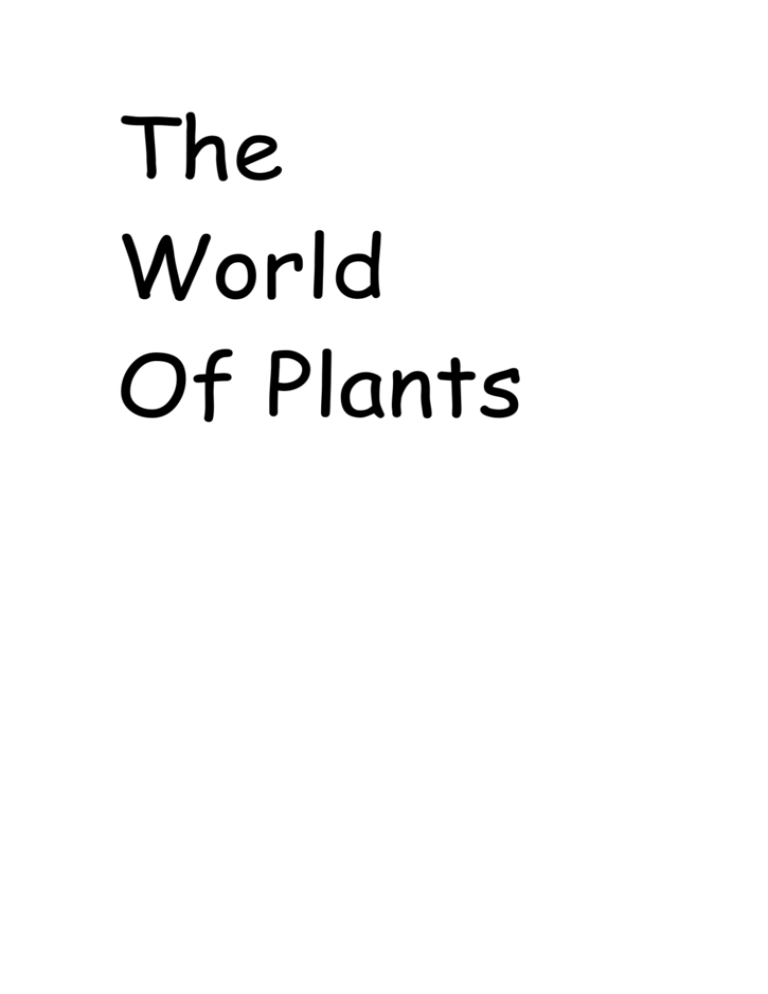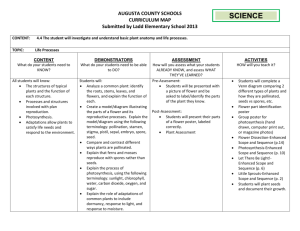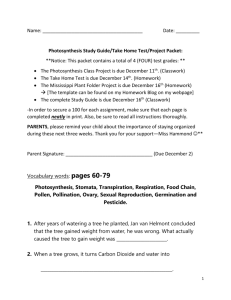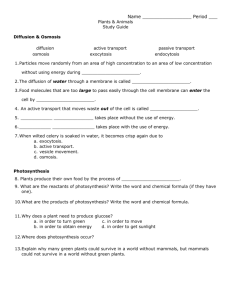World of plants notes
advertisement

The World Of Plants 2A Introducing plants The uses of plants The range of uses of plants is enormous. Not only do we eat a lot of plants as food, we also use plants as raw materials and as a source of medicines. Food examples– rice, wheat and potatoes Raw materials examples– cotton, jute and pine Medicine examples – poppy, foxglove and willow tree An example of a commercially used plant Although wood is not the most important building material now, it still is required in large quantities. Forestry is still and important industry in Scotland. Land is ploughed Seedlings planted in nurseries Seedlings planted out aged 2-4 years Fertiliser (if required) delivered by helicopter Forest first thinned out after 20 years Forest thinned from then on every 5 years Forest finally harvested after 40m -50 years The importance of plant conservation There is a huge variety of plants in the world and we exploit many of them. There are probably many species of plants that we still have not discovered and many that are in danger of extinction. New scientific techniques also mean that plants that were previously thought to be of little use can now be investigated. Therefore it is important that a wide variety of plants be maintained not only for the present use but also as potential sources of new foods or medicines in the future. 2B Growing plants In order to reproduce flowering plants produce seeds. These seeds contain nearly everything that is required to start the growth of a new plant. The structure of the seed shoot food store root seed coat The seed coat protects the seed. The food store provides food for the plant embryo until it has its own leaves and can make its own food. The root and shoot are part of the embryo plant which will develop into a mature plant. We eat seeds directly like peanuts, beans and sweet corn or we eat foods that have been made from seeds eg wheat ground to make flour. Germination Seeds that have been in Egyptian pyramids for thousands of years are still capable of growth. Seeds can be dormant but when the conditions are right, they can burst into life and produce a new plant. Germination is when a seeds takes in water and the plant embryo starts to develop into a mature plant that can photosynthesise. In order for a seed to germinate it must have the right conditions which are a warm temperature, water and oxygen. Usually, as seen above, seeds have an optimum temperature at which they will germinate best. The optimum temperature for these seeds is 350C. Structure of the flower Flowers of different plants are built to the same design although they may not be exactly alike Pollen Pollen grains are made in the anthers of the stamens and contain the flower’s male gametes or sex cells. Pollination Once pollen has been released from the anthers it has to reach the stigma and then the ovules. Pollination is the transfer of pollen grains from an anther to a stigma. Self pollination is when a flowers’ pollen grains land on the same flower’s stigma or another flower on the same plant. Cross pollination is when pollen grains from one plant are transferred to the stigma of another plant. In order for pollination to be successful pollen grains must land on a flower of the same species. Wind pollinated and insect pollinated plants These two methods of pollination have resulted in major difference between the two kinds of plants and pollen. Feature Wind pollinated plant Amount and type of Lots, light so easily pollen produced carried by wind Position and size of Hang outside the stamens flower to catch the wind Position of stigma Hang outside the plants; easier to catch pollen Scent None Colour of petals Green Nectar none Insect pollinated plant Less, sticky or with hooks Inside flower where insects can brush against them Inside flower where insects can brush against them Usually to attract insects Bright colour to attract insects Encourages insects to come to flower Wind pollinated flower Fertilisation Once the pollen grain has landed on the stigma, the male sex cell inside has to get to the female sex cell in the ovule. To do this it has to grow a pollen tube down through the style to the ovary. The pollen grain lands on the stigma and a pollen tube grows all the way down to the ovary. The male gamete travels down the pollen tube until it reaches an ovule where it fuses with the female gamete. After fertilisation, the fertilised ovule becomes a seed and the wall around it hardens to become the seed coat. Meanwhile the ovary develops into the fruit. Seeds can either be fleshy or dry. Tomato Walnut Seed dispersal The seed or seeds formed after fertilisation must be dispersed (scattered) as far away as possible from the parent plant otherwise the young plants would be competing with each other and the parent plant for water , light and space. There are three ways that seeds may be dispersed. They are wind animal internal animal external Asexual Reproduction Some plants can reproduce new plant without forming seeds. It involves only one parent and there are no sex cells. It is called asexual reproduction. During this process the parent plant produces new cells which eventually separate from the parent and become new independent plants. Pollination and fertilisation are not necessary. Runners Spider plant wild strawberry Some plants reproduce using structures called runners. These are side shoots which grow out from the parent plant. Buds form at intervals along these side shoots. These get their food and water from the parent plant until they grow their own roots. Eventually they become separated from the parent plant. Tubers Many garden plants die down in the autumn but the following spring they grow again in the same place. During the summer, they form underground storage organs which fill up with food such as starch. This organ remains dormant during the winter but in spring a new plant will grow out of it. This is also a way of reproducing because a plant produces many such storage organs, each of which can form a new plant in winter. The most commonly known tuber is the potato. Sexual reproduction versus sexual reproduction Asexual Advantages Because plantlets get food and water from parent they grow quicker Plantlets will be growing in an area which is suitable No time lost over pollination and germination Sexual Advantages A set of characteristics from each parent gives lots of variation The seeds get scattered over a wider area Clones A clone is a group of organisms which have exactly the same genetic information. So the potatoes formed from one tuber will all be a clone of the original potato. Artificial propagation Gardeners make use of a plant’s ability to reproduce asexually. Instead of growing seeds they take a small section of stem, root or leaf. Under the right conditions these will grow into a whole plant. Cuttings This is the most common method of artificial propagation. A short piece of stem with leaves is cut with a slanting cut to allow the maximum amount of water to enter the cutting. Most of the leaves are stripped to cut down water loss. The cutting can be put straight into soil or dipped in a rooting powder and then put into soil. Grafting Grafting is a special method of propagating fruit trees and rose bushes. A cutting is made of the desired plant and it is fitted to a healthy wild version of the same plant. The join is bound for awhile until the graft has healed. The commercial Advantages of artificial propagation 1. 2. 3. You can make multiple copies of a plant far faster than growing from seed. You can make many copies of popular varieties. Food plants can come into production quicker. 2C making Food Animals get their energy from food. Green plants get their energy from the sun and make their own food in a process called photosynthesis. The word photosynthesis comes from two Greek words, ‘photo’ meaning light and ‘synthesis’ to make so these two words tell us that green plants use light energy to make their own food. This can be written as an equation: Chlorophyll Carbon dioxide + water Raw materials light oxygen + glucose waste Product useful product The useful product glucose has three possible uses: 1. used straight away for energy 2. converted to starch and stored. This starch can be detected using iodine. 3. converted to cellulose and become part of the cell wall. Iodine is used to detect the presence of starch in the leaves. A brown colour means there is no starch. A black colour means there is starch present. What will happen if you deprive plants of the necessary conditions to make their food? We can set up experiments: No CO2 Leaves or whole plants without CO2 are missing an important raw material for photosynthesis so when stained with iodine the leaves stay brown showing that no starch has been produced. No light Leaves or whole plants kept in the dark are missing the source of energy to make photosynthesis work, so when stained with iodine a leaf kept in the dark will stay brown. No starch has been made No chlorophyll Some plants have areas which contain chlorophyll and are green while other areas of the plant have no chlorophyll and are white or pale yellow. When tested with iodine the green areas turn black and the white areas stay brown, showing that chlorophyll is essential for photosynthesis. The transport system of plants The transport systems of plants do two jobs. One is carry raw materials of photosynthesis and the other is to carry the products. How does water get to the leaves? One of the jobs of the plant’s transport system is to carry water and minerals from the roots to le leaves, to be used in photosynthesis. Xylem vessels – these are the tubes in the plants that carry water. They are hollow because there is no living material in them. The walls are made of lignin which is sometimes in spirals or ring shapes. Phloem – these tubes carry food from the leaves where it is made during photosynthesis to every part of the plant. Unlike xylem, phloem is a living tissue. It is composed of sieve tubes, each connected to the next by a perforated wall. They contain cytoplasm but have no nucleus. Therefore they have to have another cell alongside them, the companion cell, to control its function. Together the xylem and phloem make up a plant’s vascular tissue. In the stem the xylem and phloem are arranged on vascular bundles around the outside edge. This helps support the plant. In the root the xylem and phloem are to be found in the centre. Being in the centre makes the root more flexible as it grows through the soil. Root stem How does carbon dioxide get into the leaves? Leaves take in carbon dioxide from the air and release oxygen back into the air. Leaves have special structure for this. Leaf structure Spongy mesophyll Air space Vascular bundle Guard cell Stomatal behaviour There are tiny pores on a leaf which allow water to escape from the surface. These pores are called stomata. Gases can enter or leave through these pores. The stomata are mostly found on the lower epidermis of the leaf. Carbon dioxide gas enters the leaf and oxygen gas leaves through the stomata. Elaodea bubbler experiment When green plants photosynthesise, they produce oxygen. In aquatic plants, this oxygen is given off as bubbles, that can be easily seen. The Canadian pondweed, Elodea , has large spaces in its stem . When the stem is cut and the plant placed in a strong light, bubbles of oxygen can be seen coming from the cut end. The number of bubbles produced every minute gives us an idea of how fast the plant is photosynthesising. Oxygen gas A lamp acts as a source of light but unfortunately also provides heat. To allow the light through but not the heat, a sheet of glass or a large beaker of water is placed between the light and the test tube with the Elodea. Sodium bicarbonate is added to the water to provide carbon dioxide. Limiting factors The rate of photosynthesis is limited by the availability of essential materials or factors. A limiting factor is a factor which if in short supply will hold up photosynthesis. Light, carbon dioxide and temperature are the main limiting factors for photosynthesis. When experiments are done the limiting factors graph for light looks like this: While the graph is increasing the amount of light available is limiting the rate of photosynthesis. When the graph levels off, even if you carry on increasing the light, the rate does not change. This means that some other factor, carbon dioxide or temperature, is now limiting the rate of photosynthesis.







